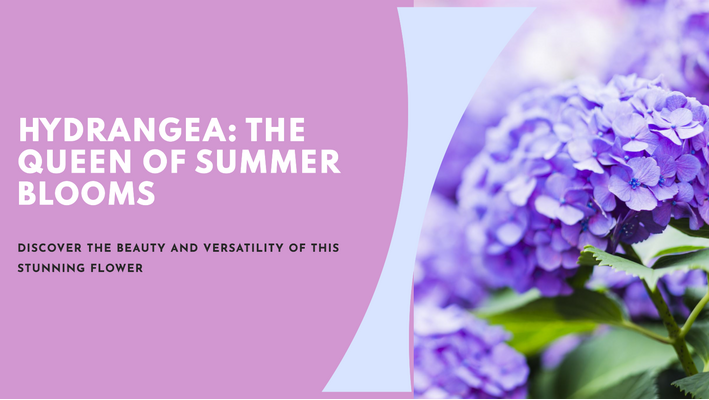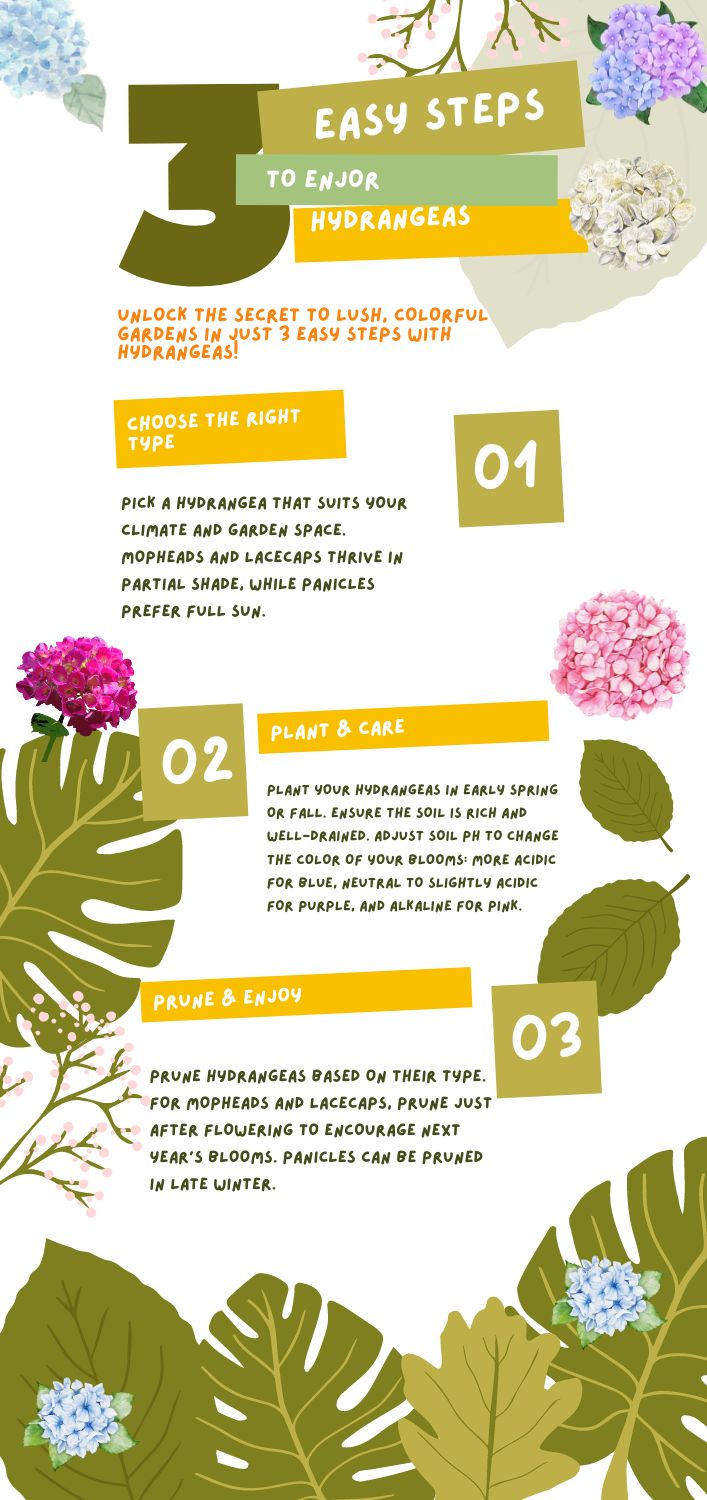Hydrangeas Uncovered: Varieties, Colour Shifts & Care Essentials

Obsessed with hydrangeas?
We can’t blame you. Loved by almost everyone, this pompom flower truly is a delight to behold. It’s the first choice of wedding florists, a favourite of gardening enthusiasts, and appreciated by everybody – from brides to grandmothers.
Because what’s there not to love about this attractive flower? It can grow in borders, in pots or containers, in group plantings, along fences, or as an informal hedge. Hydrangeas can also grow in partial to full sun, in a wide variety of soils.
Now, let’s get to know this beauty better. Here are some interesting facts about these cheerful blooms.
Hydrangea Varieties & Color Guide
Types of Hydrangea Flower Heads
Mophead
Full and round ball-shaped clusters
Lacecap
Round but flat with small center flowers
Panicle
Cone-shaped clusters of flowers
Soil pH Effect on Hydrangea Color
*Affects Hydrangea macrophylla varieties
Water Needs: High
(Name means "water vessel")
Light: Partial to
full sun
Pruning: Required for
abundant blooms
The hydrangea plant has three kinds of flower heads
There is the full and round ball-shaped Mophead, the round but flat Lacecap head, and the conical head Panicle. Mopheads are the common pompom-head hydrangeas we all know and love, with large rounded clusters of eye-catching flowers. Lacecaps display a round cluster of seed-like flat petal flowers which you can see on climbing hydrangeas. Panicle hydrangeas feature panicle-shaped or cone-shaped blooms.
The bloom’s colour is affected by the soil
When you plant Hydrangea macrophylla in acidic soil (pH below 6.0), its flowers tend toward blue and deep purple. In contrast, alkaline soil (pH above 7.0) steers the petals toward red and pink. To get a genuine purple hue—rather than a purple tipped with blue or pink—you need a soil pH between 5.5 and 6.5, which is why pure purple hydrangeas are so uncommon.
There’s one notable exception: panicle hydrangeas. Their flower colour responds to summer temperatures, not soil. They open creamy white in early summer, then progressively turn pink and finally pomegranate red as the season warms.

Its name says it all. Ever wondered why your hydrangea has a persistent thirst? Well, its name has a Greek origin that describes this plant’s insatiable thirst. The name hydrangea came from the Greek word “hydro” which means water and “angos” which means vessel, pail, or pitcher.
The flower of rain
In Japan, hydrangeas or “ajisai” are considered as the flowers of rain. They bloom in the rainy season and instantly become the perfect cure for rainy day blues in the country. Given that this type of plant loves water, they truly flourish in the rain. If you’re visiting Japan on a rainy season, that’s the perfect time for hydrangea hunting. Keep an eye on the vibrant, lustrous, and magical glow of ajisai when it’s drizzling or after a shower.
Pruning required
You won’t have flowers if you skip this part of plant care. Except for the panicle and smooth hydrangeas, mopheads grow blooms on old growths so last season’s spent flowers need to come off. It is recommended that Hydrangea macrophylla be pruned soon after flowering. Go ahead and pick the flowers to spruce up the rooms in your home.
They’re beautiful but moderately toxic. All parts of the plant are poisonous. The buds, flowers, and leaves contain glycoside amygdalin which causes cyanide poisoning. Skin contact with this toxin may cause rash or irritation. If eaten, it can cause vomiting, nausea, and diarrhea.
How To Enjoy Hydrangea in 3 Steps

Celebrate your love for this oh-so-charming flower by planting a new variety in your garden or displaying one in your home. There have been plenty of beautiful new hydrangeas that have been introduced over the past decade. From compact varieties to bi-coloured and double-flowered varieties, you have lots and lots of pretty options to fit in your landscape or to use as cut flowers.
Vase Life & Cut-Flower Use
Harvesting: Timing and Stem TLC
-
Early morning pick
Snip hydrangea heads just after sunrise, when the air’s cool and their water stores are topped up. Aim for a dry day—dew’s fine, but rainwater can dilute the natural sugars that keep petals plump. -
Sharp snips
Use clean, sharp secateurs to cut stems at a 45° angle. This maximises the surface area for water uptake—no squashed tubes or pinched vessels! -
Conditioning solutions
The moment your stems hit the bucket, give them a quick bath in lukewarm water mixed with a flower food sachet (available from Aussie garden centres or your local florist). This boosts hydration and feeds the flowers right from the start.

Longevity: 7–10 Days of Bloom (Plus Dried Keepsakes!)
-
Daily top-ups
Swap out vase water every second day. Re-cut stems by a couple of millimetres each time and add fresh flower food. A splash of white vinegar or a teaspoon of sugar can also help keep bacteria at bay in your tap water. -
Cool display spot
Keep your arrangement out of direct sun, off heaters and away from fruit bowls (ethylene gas from ripening fruit speeds up ageing). A bright, shady nook by a north-facing window in Aussie homes is perfect. -
Drying for keepsakes
When your hydrangeas start to fade, don’t toss them! Trim the heads and hang them upside down in a warm, dry spot with good airflow—think a laundry room or sheltered outdoor patio. In a couple of weeks, you’ll have beautifully preserved blooms to enjoy long after the vase life ends.
By harvesting at dawn, giving your stems a little TLC, and keeping up with their water routine, you’ll enjoy a solid week (sometimes more!) of stunning hydrangea colour. And when they’ve done their vase duty, drying them turns your arrangement into a lasting keepsake—perfect for cosy Aussie homes.
Blog Categories
Recent posts
- What 17 Years of Orders Taught Us About Toowoomba’s Flower Tastes
- 12 Christmas Wreath Decorating Ideas and Tips
- Do’s and Don’ts When Sending Christmas Flower Gifts
- The Significance of Christmas Colours in Flower Arrangements
- Stop BBQ Flowers Wilting: An Expert Guide to Flowers That Survive the Heat
- How to Select Birthday Flowers for a Man
